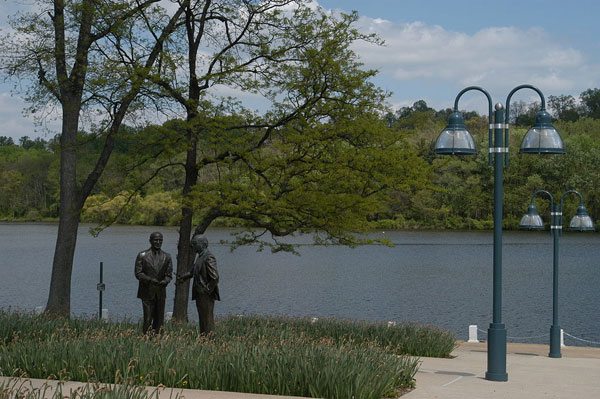
April 16, 2018; Baltimore Sun
The town of Columbia, Maryland, is experiencing a crisis familiar to many nonprofits: how to balance the mission of an organization and the principles of its founders against the practical demands of growth and change. As town officials debate whether to maintain the community centers that serve as the heart of Columbia’s neighborhoods, a bigger argument is taking place about the values that govern town decisions.
Columbia is an unusual town; founded in the New Town Movement, its history and structure make it more like a nonprofit association than a traditional municipal entity. It was founded in 1967 by James Rouse, who stated, “We should begin our total plan and program with the first and fundamental purpose of making a city into neighborhoods.” Rather than allow it to develop by fits and starts as it grew, Rouse built the town all at once.
Columbia is organized into self-sufficient “villages” that each contain an elementary school to which all resident children can safely walk, a neighborhood center, and other common facilities like pools or churches. It is governed by the Columbia Association, of which village community associations, whose members are elected by residents, form an important part.
Recently, Director of Open Space and Facilities Services Dennis Mattey recommended that eight of the 14 neighborhood centers be shut down or demolished. His memo explained that the centers needed renovations which, combined with their normal operational costs, would make them a financial burden on the association.
The centers provide space for everything from co-op and private daycares and summer camps, to bridal showers and birthday parties, to AA meetings and bilingual classes for children and adults.
Sign up for our free newsletters
Subscribe to NPQ's newsletters to have our top stories delivered directly to your inbox.
By signing up, you agree to our privacy policy and terms of use, and to receive messages from NPQ and our partners.
Residents were incensed. “You start taking away neighborhood centers, and it could be a slippery slope,” warned Dick Boulton, a member of the Columbia Association’s board of directors. Bob Fontaine, a member of the board of the Village of Harper’s Choice, said, “The proposal to eliminate the majority of the neighborhood centers is pulling at yet another thread in the fabric of our villages.” Nina Basu, who chairs the board for the Village of Long Reach, said, “I live in a 1,400-square-foot townhouse. Neighborhood centers allow me to have showers, birthday parties…It’s a very important part of the culture. These are incredibly valuable assets for everybody.” Jessica Harvey, who has run a summer camp at the Stevens Forest Neighborhood Center since 2005, said, “It would break my heart if it would go away.”
Residents also challenged that the centers proposed for closure are concentrated in older, less wealthy parts of the town where residents especially need neighborhood services, and the closures would “squeeze out of Columbia people of moderate means.” Columbia was deliberately designed as an affordable and economically and racially diverse town, and it has remained so; a 2016 study ranked it 34th in the nation for socioeconomic diversity.
Mattey said, “It is not a question of whether or not the neighborhood centers are used, but rather whether or not the long-term capital and operating expenditures add commensurate value to the Columbia community.” Of course, for a nonprofit association charged with maintaining the character, diversity, and quality of life in the town, that’s simply not true. It’s not merely a question of whether it’s financially practical to keep the centers open, but whether maintaining them is important to the Columbia Association’s mission, which many residents seem to feel is the case. Richard Larkin pointed out in 2013 that success for nonprofits is not necessarily determined by measurable outcomes, and “in fact, having a large positive bottom line may be an indicator that the organization is not doing as much as it could to fulfill its mission.” While Columbia was designed to be financially sustainable and even profitable, this can’t be the only factor in a major decision like maintaining a central element of the community’s design.
The town was designed (with the neighborhood centers) to foster community and counter social isolation, which David Brooks noted just this week is on the rise. In a paper for the Journal of Planning Education and Research, researcher and former Columbia resident David M. Levinson noted that “At each level of the hierarchy, from subneighborhood to city, there were objects to help focus identity,” such as unusual street plans and names, and the village center. The original Columbia plan “permitted no neighborhood establishments [such as bars in the center] in order to protect residents from the noise of rowdy customers and their autos and other negative externalities,” further enhancing the importance of neighborhood centers as a gathering place that didn’t require driving to reach.
Like most towns, Columbia is facing pressures due to increased urbanization and the changing lifestyles of its residents. In 2005, officials met “to develop a master plan to guide downtown’s continued evolution as the County’s economic and cultural center,” which involved making downtown “more vibrant and relevant to Columbia’s residents…increasing the number of people living downtown…while also making downtown more attractive and easier for pedestrians to navigate.” However, it must be said that Rouse explicitly did not include a metro downtown in Columbia’s design, and many residents are upset that the “old” main streets have given way to glassy apartment buildings in an urbanized downtown. They see the closure of neighborhood centers as admission that the unique nature of Columbia is giving way to market pressures.
Association officials hastened to clarify that the idea to close the centers was only a proposal and had not yet been finalized.—Erin Rubin













